
History of Morrowtown
The women of Morrowtown worked as cooks, housekeepers and nannies for local white families, including those who lived nearby on Broad and Fifth streets. In addition to driving taxis, Morrowtown men found jobs as cooks, dishwashers, construction workers and hospital orderlies. Others shined shoes downtown or worked at Alamance Laundry on Main Street. Except for low-level maintenance jobs, blacks were not allowed to work in the thriving textile business, which paid more.
Listen to some of Morrowtown’s community leaders and residents’ stories.

Morrowtown Today
Emphasizing Morrowtown is just step 1
The Burlington Community Land Trust intends to continue this model in other areas of the city identified as opportunity zones. Using source material from Destination Burlington as a guide, the Burlington Community Land Trust has identified several other neighborhoods in the city as prospective sites for partnership and engagement. Morgantown/North Park, Apple St, Beverly Hills, Graham Hopedale, Glencoe Rd, Robinson Park, Forest Hills and others are all communities the Burlington Community Land Trust wishes to engage.








